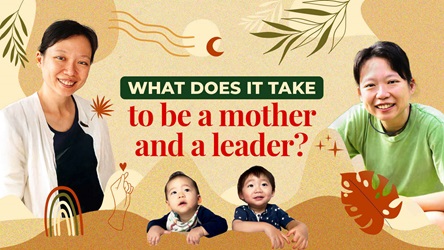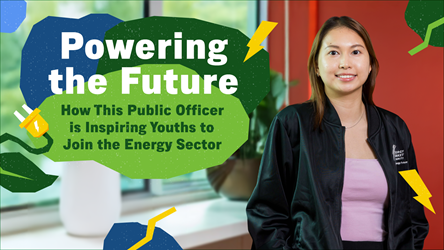“Always Start With The Perspective That A Solution Exists Somewhere”

Throughout her career in the Public Service, 2nd Permanent Secretary of Education Lai Wei Lin’s greatest challenge has been to give her best self both at work and at home.
But for the mother of three, who has twice worked part-time to devote more time to her children, her approach to every problem and challenge is simple: “I always start with the perspective that a solution exists somewhere for every problem, even if it seems like a big problem.”
“It's just a matter of finding it, after discussing the issues with colleagues, and sometimes seeking advice from a wider group. Sometimes the solution may become apparent only later, so what we have to do is try our best to manage in the meantime.”
And 2020 had been an intense working year for Ms Lai, whose main job is to oversee the development, planning and review of higher education policies and programmes. Just as it was for the school system, it was also a trying period for the Institutions of Higher Learning (IHLs), which include the universities, polytechnics and Institute of Technical Education.
Managing IHL Responses to COVID-19
Breaking down MOE’s response in terms of timeframe, she recounted the immediate need back in February 2020, and then during the Circuit Breaker period, to manage the COVID-19 response for about 200,000 students in the IHLs.
That included bringing back more than 2,000 students who were studying or on internships overseas as the COVID-19 situation around the world deteriorated, putting them, as well as thousands others, who were returning over the Chinese New Year or term breaks on Stay-Home Notices – often in campus housing.
MOE staff also worked with the IHLs to implement safe distancing measures on their very large and dense campuses, and ensure that their implementation of home-based learning worked and adjustments to examinations and assessment went well.
She revealed one memorable episode was making sure that 23,000 polytechnic students could start their first year of polytechnic education on the right foot. In a typical year, their orientation would have been in the later part of April, which would have been during the Circuit Breaker period.
“We were worried that if we didn't onboard them properly in the polytechnics, we would lose them and see a higher-than-usual attrition in this transitional stage,” said Ms Lai.
Over one weekend, polytechnic colleagues pushed themselves to advance the onboarding for the freshmen by a few weeks. They asked students to come to campus in small groups in the immediate week, to complete their enrolment processes and introduce them to the online learning management systems, while taking all safe management precautions.
Home-based learning can also be challenging for students from polytechnics and Institute of Technical Education, as many courses tend to be more hands-on, requiring quite a lot of lab work, for example.
“The lecturers had to think of how to videotape experiments and teach in that manner. Kudos to our teachers in the schools for rising to this challenge, having that spirit of adapting along the way to just keep trying,” she said.
Internship opportunities were lost too. Some of these were addressed by creating such opportunities on campus. “Rather than taking an internship at a publication firm outside, the student could write for the campus publication instead,” said Ms Lai.
With all these efforts, the schools and IHLs were able to keep learning going, while ensuring the safety of students.
Video by Eric Lin
Future Prospects for Youths
Looking further ahead to the medium and long-term, MOE had to think about prospects for Singapore’s graduates – how to make sure they are employable in the post-COVID-19 world, where jobs may pop up and disappear with a snap of the fingers?
“Very naturally we landed on this direction of needing a bit more flexibility in their training,” said Ms Lai.
For longer-term career resilience, graduates should ensure they have a sufficient breadth of skills and knowledge, so that they can pivot to another industry later if needed.
She gave an example of students who may have studied hospitality, an industry that is now in the doldrums. If the students had done modules to develop their data skills, complemented by core modules and other experiential learning opportunities that develop their soft skills, all these could be transferrable to other industries.
The IHLs were already moving in this direction, prior to COVID-19. Said Ms Lai: “Increasingly the universities are encouraging students to do a major and a minor, or a double degree.” With COVID-19, they are looking more intensively at how to support inter-disciplinary learning.
For students who prefer depth and specialisation, the IHLs would need to ensure that their learning is tailored to particular jobs in the industry, and balanced with sufficient breadth from core modules.
Video by Eric Lin
Leaving No One Behind
A major concern that underscored all these efforts was the possibility of widening gaps between the haves and have-nots.
The fear is that students from families with fewer resources, who might not have access to digital devices or help at home, might get left behind.
The good thing, Ms Lai pointed out, is that Singapore is now reaping the benefits of programmes to uplift lower-income families, which started well before the onset of COVID-19.
These include making sure that all children have access to an affordable and good pre-school education, for example, via KidSTART, broadening the types of help and to more students – like working with the community and corporate partners to widen the range of learning programmes available to them, including those whose families may not fall in the lowest income bracket.
“It’s very real that COVID-19 can widen those inequalities, but having built some of that capability within the system, we are better poised to have a wider network of resources to leverage in response,” she said.
She said: “Schools loaned out a lot of devices and dongles, and community partners came in to donate devices. We felt the partnership of many good-hearted Singaporeans and groups who worked with us on that.”
Video by: Eric Lin
Finding Work-life Balance
On the personal front, having decided that integrating both work and life is the way to go, Ms Lai was able to adapt to the work-from-home arrangements during the Circuit Breaker.
In a regular year, her typical routine is to leave the office on time and resume working again after dinner and after her youngest child, a 12-year-old boy, has gone to bed. Her other children are two daughters aged 15 and 17.
Speaking about work-from-home arrangements during Circuit Breaker, Ms Lai said, “When I worked from home, I shared a working space with the three kids. Unless it was urgent, they knew not to disturb me,” said Ms Lai.
Juggling multiple roles is yet another challenge that Ms Lai, who took on the additional role of Permanent Secretary at the Ministry of Law since September 2020, has been resourceful about finding solutions to.

During her seven-year stint at the Ministry of Health, there were times when she would bring one of her children along with her to community dialogues on the weekends. In between assisting participants with their questions, she would keep an eye on her child, who might be doing a spot of colouring in his or her seat.
On another occasion, bereft of childcare options, Ms Lai brought her daughter, clad in ballet garb, to a Saturday networking lunch between her Minister and journalists.
“My daughter stayed outside in her ballet costume – eating bread, practising her moves, and reading – with the Minister’s security officers nearby,” recalled Ms Lai.

What’s in your Cuppa?
Lower sugar 3-in-1 coffee
How often do you have it?
Once a day to start the day

To get more stories like this, subscribe to the Challenge Telegram channel.
- POSTED ON
May 3, 2021
- TEXT BY
Wong Sher Maine
- PHOTOS BY
Norman Ng









